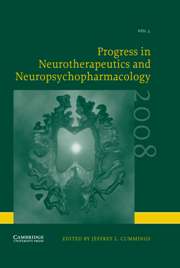No CrossRef data available.
Article contents
Symptomatic Remission in Patients with Bipolar Mania: Results from a Double-Blind, Placebo-Controlled Trial of Risperidone Monotherapy
Published online by Cambridge University Press: 05 March 2007
Extract
ABSTRACT
Background: The purpose of this analysis was to compare symptomatic remission rates between risperidone and placebo in a completed randomized controlled trial. Design and Methods: Two hundred ninety (290) adult patients who met DSM-IV criteria for Bipolar I Disorder Manic or Mixed episode were randomized to flexible doses of risperidone or placebo for 3 weeks. An entry Young Mania Rating Scale (YMRS) score of > 20 was required at trial screening and baseline. Time to first onset of remission (as defined as a YMRS score of < 8) was assessed using Cox proportional hazards. Persence or absence of sustained remission was analyzed using logistic regression. Sustained remission was defined as maintaining a YMRS < 8 for the remainder of the trial or until censor. Results: After adjusting for presence of psychosis, baseline YMRS, gender, number of mood cycles in the previous year and treatment,the odds of sustained remission for subjects on risperidone was 5.6 (p < 0.0001). Similarly the adjusted hazard or remission for subjects on rsiperidone was 4.0 (p < 0.0001). Interpretaion: A statistically significant proportion of manic patients receiving risperidone monotherapy achieved symptomatic remission within 3 weeks as compared to placebo.
Keywords
- Type
- Review Article
- Information
- Progress in Neurotherapeutics and Neuropsychopharmacology , Volume 2 , Issue 1 , March 2007 , pp. 213 - 224
- Copyright
- © 2007 Cambridge University Press


